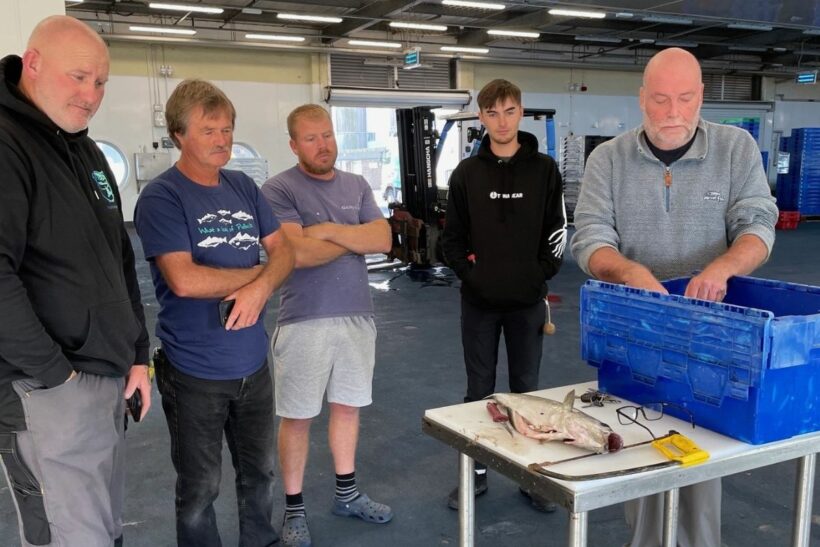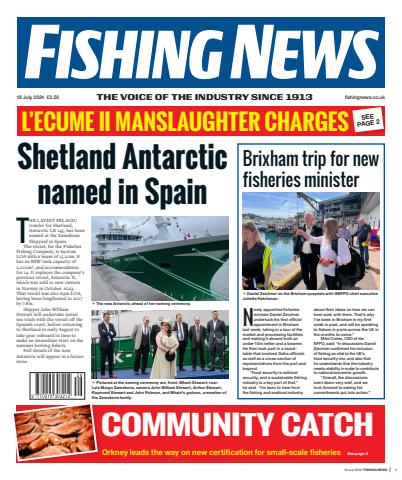Ten South West fishermen participating in industry-led data collection initiative
South West pollack fishermen, many of them working from inshore vessels using rod and line, have successfully rolled out an industry-driven initiative that they say could inspire other similar science projects, as well as provide a rapid feed into decisions about the pollack TAC.
The Plymouth Fishing and Seafood Association (PFSA) and Cornish FPO (CFPO) developed a successful joint application to the Fisheries and Seafood Scheme to contract 10 fishermen to collect data on pollack bycatch, after the shock zero TAC decision for 2024 prevented any targeted fishing for pollack anywhere in area VII.
The project, part-funded by The Fishmongers’ Company, saw 10 fishermen from Plymouth and North and West Cornwall receive training from Dr Simon Thomas prior to collecting data on the pollack bycatch – 200kg per participant per month – that the boats are allowed to land, including length, age, sex and details about fishing effort.
Another industry member has been trained to support data collation and collection ashore, for the limited bycatch of pollack being landed into Newlyn and Brixham markets. They are also taking mucous and fin samples. This will significantly increase the total number of pollack sampled, and improve understanding of the age classes of the fish landed.
The data is being combined with that from the charter anglers’ Fisheries Industry Science Partnership (FISP) project on pollack led by the University of Plymouth (FN, 25 January, ‘The secret life of pollack’). The inclusion of commercial vessel data into this dataset will provide an insight into the quantity of bycatch experienced by commercial fishermen, and give a wider coverage of samples than currently being collected by the FISP project.
The data will be processed and provided to ICES and Cefas to allow its inclusion in future stock assessments. The zero catch advice from ICES last year – with a total bycatch in area VII of 823t – admitted that ‘stock structure is poorly defined’ and that ‘the surveys used to calculate the index do not target preferred pollack habitat, and the index is based on few samples’.
The ongoing development of Fisheries Management Plans across all UK fisheries require the fishing industry to contribute to filling data gaps. Edward Baker, CEO of the PFSA, said: “This science project is one of three in the South West this year that involves fishermen in data collection to support stock assessments. The other two are run by Cefas, one a genetic study on pollack and the other sampling small-eyed ray.
“This project, however, is industry-led. The data collected is owned by the fishermen, PFSA and CFPO and this gives the fishermen a greater sense of stewardship.”
Chris Ranford, chief executive of the CFPO, said: “It is hoped that it will encourage other industry-led science projects. There are clear cost benefits associated with involving the fleet in research.
“It is feasible that in the future, data collection will be primarily collected from the fleet, allowing scientists to focus their efforts on analysing these data. This approach would greatly reduce the need for costly at-sea observers, whilst increasing capacity and data.”
Edward Baker added: “We are hopeful that this data will demonstrate the benefit of fisher-led data collection, using a method that reflects the actual behaviour of the fish, rather than basing assessments on landings data and trawl surveys. Data collected by this project will be presented to the industry, science and policy bodies on completion.
“The data will contribute to a more comprehensive assessment of the pollack stock in area VII, but a robust dataset needs to be collected over five years – and for both this project and the FISP project, the current funding only extends to March 2025.”
Tony Heinemann is one of the 10 fishermen supplying bycatch data to the trial. “This year we have not targeted any pollack as such, as we don’t have the quantity of quota to do so,” he said. “The monthly allowance of 200kg is just a good day fishing for pollack if you are targeting them. The zero TAC and bycatch rules have reduced our income by 30%.
“Next year I may have to look at some form of netting to compensate the loss. We have already fished further afield this year, as we went to Portland to fish for early-season bass, which did help slightly – but that came with extra expenses.
“I tend to stay away from wrecks now when targeting bass, to avoid the pollack – even when targeting bass in these areas, we would still need 500kg a month bycatch. I just hope this extra data helps the cause. We’re pleased to be working on this and passing real-time data to scientists, ahead of any decision about managing next year’s fishery.”
This story was taken from the latest issue of Fishing News. For more up-to-date and in-depth reports on the UK and Irish commercial fishing sector, subscribe to Fishing News here or buy the latest single issue for just £3.50 here.
Sign up to Fishing News’ FREE e-newsletter here.






